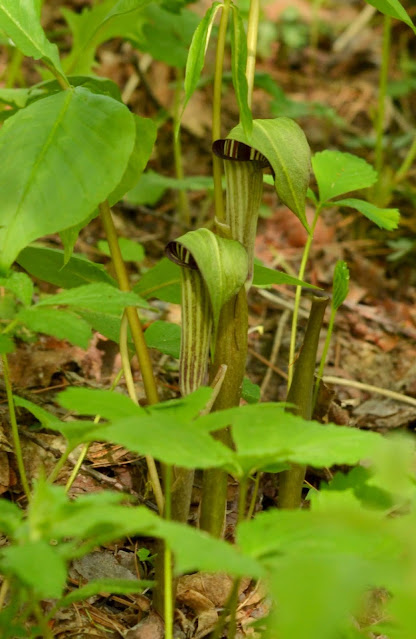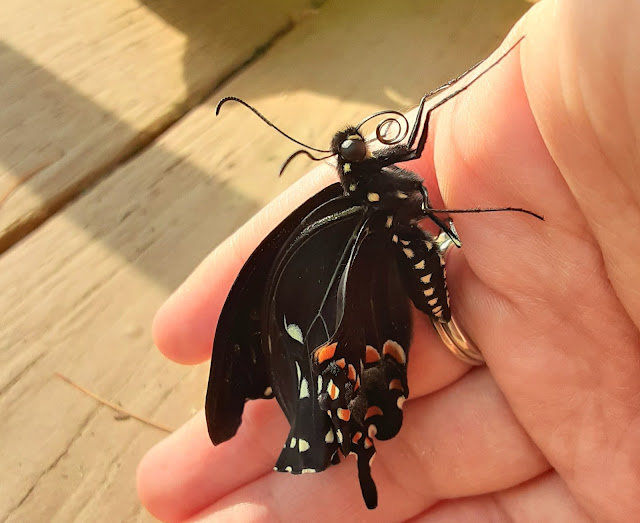2023 is almost over, so it's time to finish catching up with this year's sights from around our property! In the previous post, we got up to the middle of July. Let's take it from there! This post shares some highlights from the rest of summer in our yard, meadow, and woods; and then I'll finish up the year (fall and early winter) in another post.
Late in the afternoon on July 29, I heard some strange noises and saw flashes of a small long mammal darting between clumps of brush in our yard. The daylight was fading, but I grabbed my camera anyway, because I'd never seed a weasel-type creature in our yard before. (All previous sightings on our property have been courtesy of the trail camera in the woods.) Sneaking around the area, I must have accidentally ended up in the creature's intended path, because a Long-tailed Weasel came directly toward me, suddenly found a human blocking its way, and dropped the baby rabbit it was carrying at my feet. I guess we were both surprised! I backed away a bit, and the weasel came back and snatched up its meal again:
The weasel carried the rabbit to a spot behind our shed, and then it came back along the same route and repeated the process at least five more times (I lost count) while I watched from nearby. That's a lot of baby rabbits! I was wondering at the time whether the weasel could have been gathering food to feed its own young, but I've also read that weasels sometimes cache food -- more than they can eat at one time -- so maybe that's what was happening here. In any case, it was pretty amazing to see this confident and capable little hunter at work! All my picture attempts were blurry, but this gives an idea of the action at least:
While all this was happening, a Mourning Dove was watching from its nest in a tree right over the weasel's path:
Yikes, being a nesting bird sure seems perilous. Here's another picture of this Mourning Dove the next day, in better light -- this nest didn't ultimately succeed, and I don't know whether that was because of the weasel, or another predator, or some other hazard:
I had a lot of fun this summer trying to take pictures of Ruby-throated Hummingbirds as they visited the various hummingbird-friendly flowers in our yard. I don't keep hummingbird feeders, but it turns out that many of the (mostly native) flowering plants I've added to our property over the years (and some of the annual flowers I grow, too) are great feeding stations for these lovely little birds. It seemed like we had hummingbirds around pretty much all the time this summer, so there were lots of opportunities for pictures.
The big orange flowers on our Trumpet Creeper vine are always a big hit with the hummingbirds (and there are always many big black ants on these flowers, too) -- here's a hummingbird visiting these flowers on July 30:
I've noticed that hummingbirds visiting Trumpet Creeper flowers tend to leave with white foreheads, thanks to a generous dusting of pollen:
The Scarlet Runner Beans I grew in my vegetable garden this year were also popular with the hummingbirds, and I so loved having these birds come visit while I was in the garden. Here's the same bird from the above pictures again, now shifted to Scarlet Runner Bean flowers (also on July 30):
And here's a closer picture of another bird on August 13:
After visiting the bean flowers, this hummingbird perched for a bit on top of a post in the garden (I wonder what all that white stuff is along the top of its beak):
Look, a hummingbird tongue! Wow, what a cool little bird:
Ever since I planted Cardinal Flowers in our yard back in 2017, I've been hoping to get a good picture of a hummingbird visiting these flowers, and I finally managed it this year by peeking through our living room window and using our house as a blind on August 13:
Ah, I love these flowers, and it's so awesome to see them with their primary pollinator. And this was the first time I really got to see this flower's pollination mechanism at work! While the hummingbird drinks, the flower gives it a little pat on its head -- soooo cool:
The Coral Honeysuckle I planted in our yard last year bloomed for the first time this year, and the hummingbirds were very much into these flowers, too. Here's a bird visiting these flowers on September 4:
This bird was even able to perch on the honeysuckle's vine while feeding from these flowers:
What a sweet bird:
And here's one more picture from September 4, since this bird's feeding route also included the nearby New York Ironweed flowers:
There are always tons of flowers around here during the summer, and here's a small selection of some other blooming plants that caught my attention this year. Enchanter's Nightshade (Circaea canadensis) grows in our woods, and I love its dainty flowers and its whimsical name; this picture is from July 21:
Narrow-leaved Meadowsweet (Spiraea alba) -- also pictured here on July 21 -- produces its puffy sprays of white flowers at the back edge of our meadow:
Pokeweed grows abundantly in our yard and meadow, and birds enjoy its purple berries in the fall; I admired these Pokeweed blossoms on July 26, with white spheres opening to reveal green globular structures:
And a bee was also enjoying these pretty Obedient Plant flowers in our front yard on August 13:
And here are a few more assorted sights!
A juvenile (pink mouth) and adult (dark mouth) Blue Jay making a noisy scene in the yard on July 20:
A very puffy Black-and-White Warbler that let me approach unusually close on July 21 -- I hope this bird was OK! It moved along soon after I took this picture:
A couple of Red Efts (juvenile Red-spotted Newts) ambling over the ground in the woods, this one on July 21:
And this one on August 13 (I have a hard time resisting an opportunity to hang out with these little creatures!):
Bunches of abundant Chokecherry (Prunus virginiana) berries on July 21:
A young American Bullfrog at the small pond in our woods on August 13:
A fantastically strange female American Pelecinid Wasp (Pelecinus polyturator) in our yard on August 23:
Here's another view of that same wasp:
A Chestnut-sided Warbler in its muted -- but still beautiful -- late-summer costume on August 24:
A young White-tailed Deer starting to grow out of its spots, seen in the woods on August 29:
Another view of this same deer, as it tried to figure me out:
A sleepy bee underneath an aster bud in the late afternoon on September 1:
And a view on September 4 from beneath the Black Cherry trees covered with Virginia Creeper vines at the edge of our woods:
Finally, here are some assorted clips from the trail camera in the woods during July and August. This video features a young White-tailed Deer browsing along the trail, two Coyotes, a Ruffed Grouse (possibly a male, with those dark feathers on the sides of its neck), a deer sniffing the camera, and a family of American Crows taking a stroll down the path:

















.JPG)
.JPG)








%201.JPG)
%202.JPG)











































